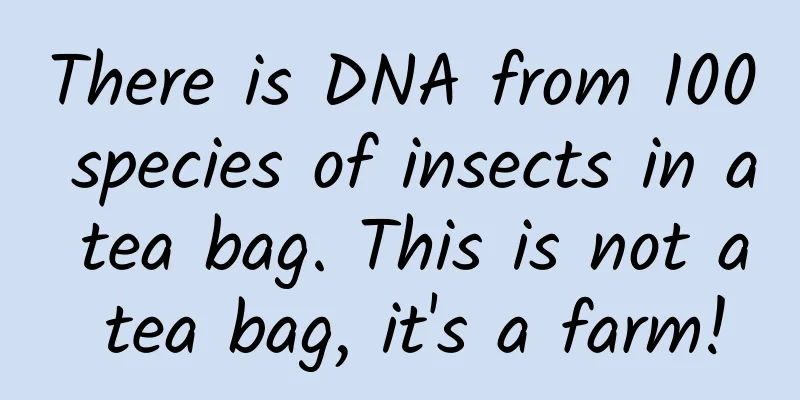There is DNA from 100 species of insects in a tea bag. This is not a tea bag, it's a farm!

|
It is said that eating half a worm is more terrible than eating a worm. But in fact, being able to see the worm is already considered to be quite conscientious! For example, coffee and chocolate contain more bug fragments than we can imagine, but we just don’t know it! (And this is still qualified...) According to the testing standards of the U.S. Food and Drug Administration, chocolate is considered qualified if the average number of insect fragments per 100g is less than 60. Some people may think, fortunately I don’t like chocolate or coffee. But can you…escape tea? A recent study published in Biology Letters found that green tea bags contain DNA from more than 400 insect species! Help! I want to drink tea, not the insect "soy milk"... Is this a problem with the quality of the tea, or is it just an unavoidable, everyday occurrence that no one can escape? 1. DNA ≠ insect existence The test conducted on tea bags in this study is called environmental DNA (eDNA) testing. The test object is all the DNA directly extracted from the tea bag. Then, through some molecular biological methods, the sequence information of these DNAs is obtained, and the obtained DNA fragments are compared and analyzed with the database of known species information to identify the species classification information to which they belong. eDNA detection based on next-generation sequencing technology Source: pexels First of all, you can rest assured that the presence of insect DNA in tea bags does not mean that there are fragments of these insects in the tea . In fact, these insects may leave their own DNA just by resting on the leaves for a while. Just like when people walk on the road, they may leave a large amount of human DNA when they sweat, lose hair or touch the surrounding environment. According to statistics, a person sheds about 2*107 skin cells per hour on average, and each cell contains an unimaginable number of DNA fragments. Therefore, even a small insect will continue to scatter exoskeletons, secretions, and even feces rich in DNA fragments in the place where it lives throughout its life . Therefore, the DNA detected in the tea bag can only prove that the owner of the DNA has appeared in this environment, but it does not mean that it is still in the tea bag. It is like finding the murderer's DNA at the crime scene, but the murderer cannot still be squatting at the scene honestly. Since testing cannot prove that these insects really exist in tea bags, why do scientists test these tea bags? This actually involves the real use of eDNA testing - discovering traces of biological life through environmental sampling. 2. The Small World in a Tea Bag The research team originally wanted to explore the insect ecology in the local planting area, so they worked hard to collect samples at various points in the field to extract eDNA. Unfortunately, they found that DNA fragments existing in the wild are easily broken down by ultraviolet rays or washed away by rain. Ms Mieke van der Heyde collects samples for eDNA analysis Source: Curtin University In contrast, DNA fragments can be preserved relatively stably in samples stored in a dry and dark environment. But where can we find such "large quantity and high quality" samples? The researchers suddenly thought of another plant product that was stored in dry, dark conditions: tea. Scientists began a new attempt. Compared with collecting plant samples in the wild, collecting tea samples is much easier, and you can choose them at will in the mall. In the end, they selected three commercially available teas, two green teas (Camellia sinensis) and one dandelion tea (Taraxacum sp.). Unlike typical eDNA sample extraction, they did not use the traditional method of repeatedly washing the tea leaves and filtering out the DNA particles from them, but directly extracted DNA from the crushed tea leaves. Therefore, the DNA proposed includes not only the arthropods that may exist on the surface of the tea leaves, but also the DNA of the plants themselves and impurities such as fungi that may exist in the soil. Cluster analysis of arthropod DNA sequences in tea bags Source: pexels As expected by the scientists, they successfully obtained a large amount of DNA from the tea samples, and then analyzed and identified the DNA of the arthropods in them. They finally found that in just 100 mg of tea samples, they identified DNA traces of about 1,000 arthropod species. By comparing tea with samples of other crops such as mint, chamomile and parsley, it was also found that there are 1,142 types of unique insect DNA in tea, which is extremely abundant. This is not a tea bag, this is a farm! Of course, for ordinary people, this incident also means another sad fact - no matter what kind of tea it is, no one can escape the insect problem. eDNA methods for assessing biodiversity across insect species Source: pexels Scientists were delighted by the results of this study. They did not expect that tea would perfectly retain arthropod DNA fragments. This may be because tea needs to be ground during processing, causing DNA from the entire growing area to be mixed together. The large amount of data obtained was even enough for researchers to reconstruct changes in insect communities in German forest ecosystems over the past 35 years. 3. The rich uses of eDNA testing In fact, after years of development, eDNA testing has been used in various fields. In addition to environmental biodiversity surveys, it can also be used to survey specific organisms. The tea bag test mentioned above is a typical environmental biodiversity survey. eDNA also plays a huge role in the investigation of specific organisms. Compared with the "wide-net" and "full coverage" environmental biodiversity surveys, the goal of specific biological surveys is to find out whether the DNA of the target (single) species exists in environmental samples. More precise quantitative PCR (qPCR) technology is usually used in sample processing to study and track the distribution of rare species in nature. On April 12, 2018, researchers from Washington State University in the United States conducted eDNA testing in some waters in Southeast Asia and discovered the presence of DNA of the critically endangered Yangtze Yangtze softshell turtle. They believe it may be the fourth Yangtze Yangtze softshell turtle in existence worldwide, but they only discovered its DNA and have not seen its true body. Yangtze giant softshell turtle Photographer: Qi Shuo At the subsequent first marine environmental DNA conference, some scholars proposed that when tracking and monitoring endangered species or investigating marine biodiversity, traditional fishing methods should no longer be used, and more attempts should be made to use eDNA detection methods. In the past, biodiversity surveys in water bodies mostly used methods such as fishing, trawling, and diving. People could only catch more than 20 different species of fish after a whole day of work. However , using eDNA testing, more than 100 species can be detected in the same waters. The test samples only need to be collected from water, and the test results are more scientific and reliable. Fish sample information can be obtained by detecting eDNA in water bodies Source: pexels With the development of gene sequencing technology, the efficiency of eDNA testing is getting higher and higher. After the detection cost is reduced, it can be used more in other fields, such as detecting whether edible meat is adulterated, detecting geographical indication specialty products protection products, etc. I believe that this technology will play an increasingly important role in the future. However, people who like to drink tea can only comfort themselves like this in the future - it doesn’t matter, it’s just some insect DNA, cat poop coffee is still... right? END Audit expert: Wang Guoyi, Postdoctoral Fellow in Food Safety Tadpole Musical Notation original article, please indicate the source when reprinting Editor/Xiao Xitushuo |
<<: This little sparrow-like creature is more skillful than a human in cracking melon seeds.
Recommend
Latest Age Regulations for Construction Workers 2022: What is the age limit for migrant workers on construction sites?
In rural areas, many farmers are forced to work i...
Plex: 2022 Smart Manufacturer Report
7 Current Status of Intelligent Manufacturing Acc...
How to make Tik Tok videos popular? Tips and methods for shooting Tik Tok videos
Many friends have encountered this situation: the...
Yang Liang's English Vocabulary Memorization Guide 40 Episodes
Course Outline 00 The five most common mistakes C...
One reason is enough to persuade you to eat more figs!
Now is the season for figs. Looking at the plump ...
Don’t worry if your old iPhone gets soaked in water. It can repair itself in 7 minutes
Except for Sony, Samsung, and iPhone 7, most mobil...
Marketing promotion skills: Turn the masses into a “mob”!
Introduction: It is not only Socrates who was kil...
Google's Android M secret weapon: built-in theme engine
Google launched the Android M developer preview f...
Users no longer like to buy your product? Try these 3 strategies
A product may be very popular at the beginning, b...
Xiaomi's car-making partner confirmed? SAIC-GM-Wuling officially confirms
It is reported that the official account of SAIC ...
DeepLink page jump technology between mobile applications
Introduction to DeepLink DeepLink is a technology...
When buying traffic for information flow advertising games, take care of these 4 factors to increase the payment rate!
There are always people living in a higher dimens...
How to use the "expert" economy, which is more lethal than "Internet celebrities", to market products
Jiuzhilan Interview: A one-stop strategy for buil...
WeChat Mini Programs to attract traffic and promote, how to promote WeChat Mini Programs to attract traffic?
It is becoming increasingly difficult to do physi...
Methodology: Brand promotion from 0-1!
Last year, I thought that after working in brand ...









